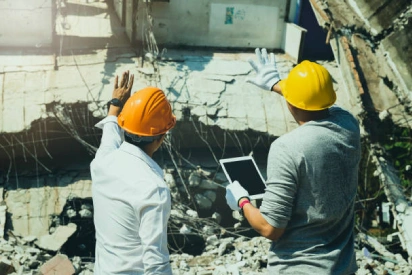Adaptive Building Envelopes: Responding to Environmental Changes in Real-Time
New Heaven Developers June 18, 2025

What Is a Building Envelope and Why Does It Matter?
The building envelope refers to the physical barrier between the indoor environment and the external climate. This includes walls, roofs, windows, doors, and foundation elements. It plays a critical role in protecting the structure from weather elements such as heat, cold, wind, rain, and humidity. More importantly, it regulates indoor temperature, air quality, and moisture control. Traditional building envelopes are static by design. Once installed, they cannot respond to shifting environmental conditions. This lack of flexibility often leads to energy inefficiencies and increased wear. This is especially true in regions like Altadena and the Palisades where climate variability is increasing due to changing weather patterns.The Rise of Adaptive Building Envelopes
Adaptive building envelopes incorporate technology and smart materials to sense environmental changes and respond accordingly. Instead of simply acting as a barrier, they become active participants in managing heat flow, light penetration, moisture, and ventilation. This responsiveness helps maintain indoor comfort. It also reduces the energy load required for heating, cooling, and ventilation systems. We see these systems as transformative tools for building resilience. They help homeowners reduce energy costs while enhancing structural longevity. This is particularly important in homes rebuilt after disasters, where resilience and efficiency must go hand-in-hand.How Adaptive Envelopes Work
Adaptive envelopes rely on an array of sensors, actuators, and smart materials that work together to respond to environmental stimuli in real time.- Sensors detect external and internal conditions. These include temperature, humidity, solar radiation, and wind speed.
- Actuators then trigger mechanical or chemical changes in the building components. This may involve opening vents, adjusting shading devices, or altering insulation properties.
- Smart materials, like thermochromic glass or phase-change materials, actively modify their behavior. They do this based on temperature or light exposure.
- Heat gain and loss through walls and windows
- Daylight entry to balance illumination and glare
- Airflow for ventilation and moisture control
Examples of Adaptive Envelope Technologies
Several technologies exemplify how adaptive envelopes function in practice:- 1. Dynamic Facades and Shading Systems These include louvers, blinds, and shading panels that adjust automatically based on sun position and intensity. By controlling solar heat gain, these systems prevent overheating during summer. They also maximize warmth during winter.
- 2. Smart Windows Electrochromic or thermochromic glass changes tint or transparency to regulate sunlight penetration and reduce glare. This adaptation helps maintain stable indoor temperatures. It also reduces reliance on artificial lighting.
- 3. Responsive Insulation Materials Phase-change materials embedded in walls absorb and release heat based on temperature fluctuations. They smooth indoor temperature swings and reduce HVAC loads.
- 4. Automated Ventilation Systems Operable windows or vents controlled by sensors open or close to optimize airflow and humidity levels. This prevents moisture buildup that could lead to mold or structural damage.
Benefits of Adaptive Building Envelopes for Disaster-Prone Areas
Our focus at New Haven Developers is always on the unique needs of the homeowners in Altadena and the Palisades. These are regions where rebuilding often follows wildfire, earthquake, or flood events. Adaptive envelopes offer critical benefits in these contexts:- Enhanced Energy Efficiency: By reacting instantly to changing weather, adaptive envelopes reduce heating and cooling demands. This lowers energy bills and the home’s carbon footprint.
- Improved Indoor Comfort: Real-time adjustments help maintain a more consistent indoor climate. This is especially important for vulnerable populations during extreme weather events.
- Increased Durability and Resilience: By managing moisture and airflow actively, adaptive envelopes reduce the risk of water damage, mold growth, and material degradation. These are common post-disaster concerns.
- Customization for Site Conditions: Adaptive systems can be fine-tuned to local environmental factors such as altitude, sun exposure, and prevailing winds. This provides homeowners with solutions tailored to their specific context.
Challenges and Considerations
Implementing adaptive envelopes does require careful planning. At New Haven Developers, we consider several factors:- Integration with Existing Systems: Adaptive envelopes work best when integrated with HVAC, lighting, and building management systems. We coordinate closely with engineers to ensure seamless communication and control.
- Initial Costs and Return on Investment: While upfront investment can be higher than traditional construction, the energy savings and durability benefits typically result in lower lifetime costs.
- Maintenance and Durability of Components: Moving parts and electronic components require maintenance to ensure long-term performance. We design systems with durability in mind and select robust materials suited for our local climate.
- Regulatory Compliance: Adaptive building envelopes must meet building codes and standards. These regulations are still evolving in many regions. We work with code officials and stay current with emerging regulations.
Our Approach to Adaptive Building Envelopes
We integrate adaptive building envelope principles from the earliest design stages. We collaborate with architects, engineers, and homeowners to select the right combination of materials and systems. These are tailored to each project’s unique environment. Our process includes:- Site analysis to understand microclimates and exposure
- Performance modeling to predict energy and comfort outcomes
- Selection of adaptive technologies that align with homeowner goals and budgets
- Installation by skilled technicians trained in smart building systems
- Ongoing support to monitor system performance and make adjustments if needed
